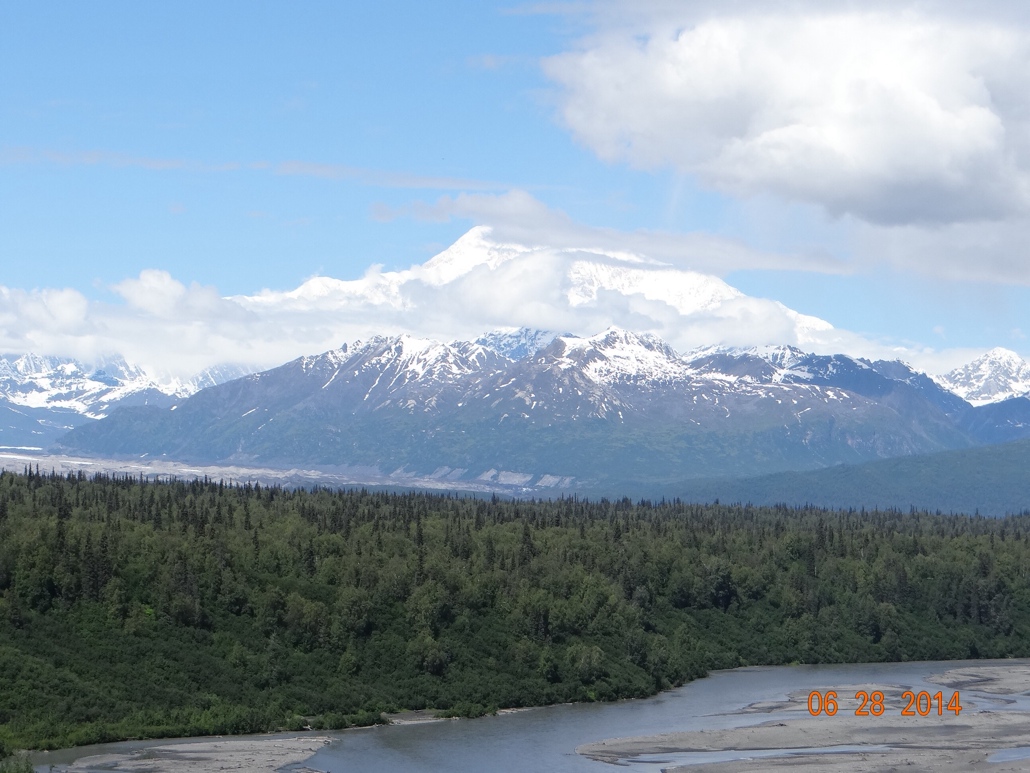In the previously published version the pictures did not upload for some reason. I’ll assume it was operator error. Anyway they should appear in this version.
Dandy Don Meredith used to sing that in the very early days of Monday Night Football toward the end of the game or when it looked like a victory was in hand for one team or the other. However, in this case, it appears that the Alaska portion of our vacation is about to end. I am writing this from Tok (pronounced “toke”, not “tock”) which is on the Alaska Highway and one of the first towns we visited in Alaska. I don’t think I have mentioned Tok before and I won’t really say much about it now either except that that’s where we are. The reason is that there’s really nothing to say about it. Everyone who drives to Alaska comes through here because they have to. The town consists of four or five RV parks, a couple of gas stations and a restaurant or two. Nothing too exciting, and the plan is to leave here tomorrow morning headed back into Canada for the long trip to the lower 48.
When we were in Tok about a month ago we had to make a decision on which way to go out of Tok. The highway system in Alaska essentially makes a big circle and from Tok we could continue heading northwest toward Fairbanks or we could have headed southwest toward Anchorage. Since it was fairly early in the season I wanted to go toward Anchorage in the south and give the Fairbanks area in the north more chance to warm up. Joan voted to go toward Fairbanks and then to Denali National Park because she thought Denali would get more crowded as the season progressed. I don’t always win these disagreements and this was one of those times. However, as it turned out, I’m glad we went the way we did, but not because of weather nor overcrowding. I’m of the opinion that the best sights and scenery are in southern Alaska, not the interior portion where Fairbanks is. Had we seen all of the best “stuff” first and then headed up toward Fairbanks I don’t think we would have appreciated that part nearly as much.
From Soldotna where I wrote the previous post, we did a day trip in the car down to Homer on the coast. Homer is a little fishing village surrounded by glaciers which are highly visible as you begin to drop down out of the mountains and head into town. The interesting geological feature of Homer is what is called the Homer Spit. It is a very narrow spit of land that extends out into the bay for about a mile. The spit itself is covered with RV parks, saloons and the typical tourist gift shops. The harbor is behind the spit in the protected waters, and sea planes were constantly taking off and landing in this area also. A noteworthy feature of the harbor was the extremely tall pilings that the docks are attached to. In Florida we get normal tide flucuations of perhaps just a couple of feet. But in southern Alaska the normal tide flucuates around twenty six feet. So the docks, gangways, etc have to be built to move up and down that much.

When we left Soldotna in the motorhome we headed for the town of Seward. Seward is another small fishing town on the coast. The main attraction for us here was Kenai Fjords National Park containing Exit Glacier which is another glacier that we could walk to. It was a mile and a half hike each way. While I was driving Joan had read all about it, and I think she just failed to mention to me that it was steep uphill the whole way. But the strenuous hike made the other attraction that we found in town, The Seward Brewing Company, that much better. The Exit Glacier was beautiful, but we did not visit it again the next day like we did The Seward Brewing Company!
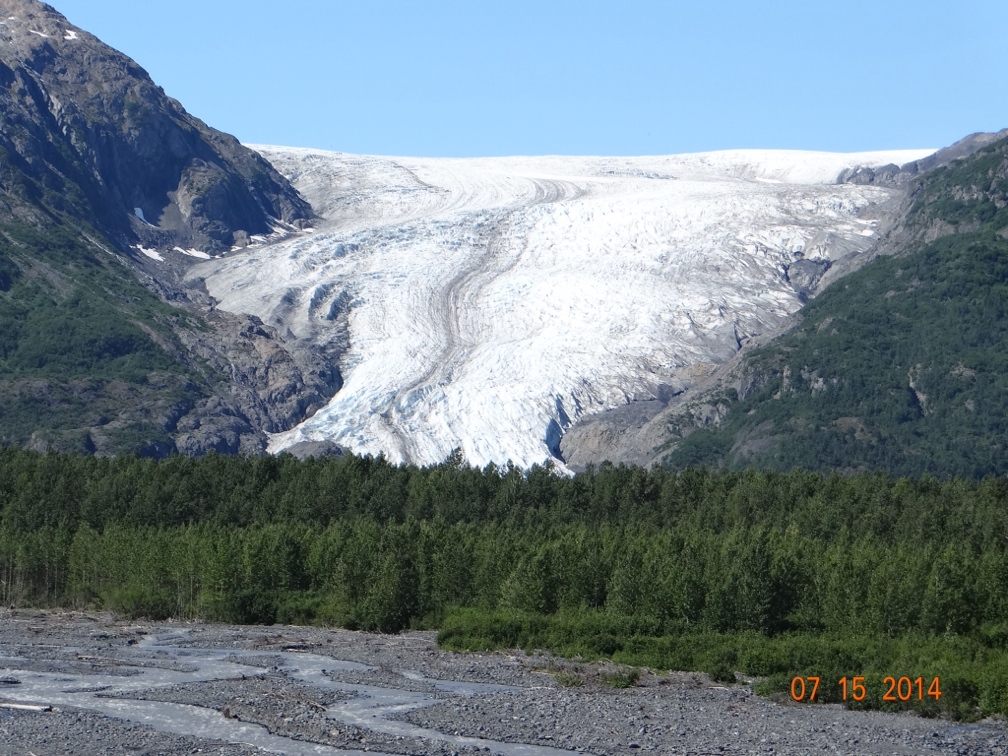
The town of Seward is named after William Seward who was the Secretary of State in 1867 under Andrew Johnson. It was he who was friends with the Russian Minister of Foreign Affairs and they negotiated the purchase of the Alaska Territory from Russia. At the time the Russians were afraid of the Brits invading Alaska through Canada and they did not wish to defend the territory. The price we paid was $7,200,000 which works out to be about two cents per acre and the deal was negotiated as a treaty requiring Senate approval. Just as today there was wide disagreement in the country and especially in Congress as to whether Seward got a good deal. Those who did not called the purchase Seward’s Folly. The Senate finally ratified the treaty and in 1867, the House voted the funds and the deal was done.
The concept of one country purchasing land from another country as we did with Alaska and as we did in 1803 with the Louisiana Purchase from France seems rather novel today. Now if the Russians want Crimea they just kind of maneuver around and take it. As I think about it there might be a couple of states I would be willing to sell. How about California? Or if not all of it how about just a couple of cities there. Or even a congressional district? One in particular comes to mind, but again I digress.
From Seward we had to return to Anchorage for a couple of days because I had scheduled an oil change for the motorhome, and a Jiffy Lube just will not work for that. When I dropped it off the service tech asked me if I wanted anything else done besides the oil change. I thought about it for a few seconds and told him to put an air filter in since we have been on some rather dusty roads. I realized this would not be the normal $20 or so filter that goes in a car and figured that it might even cost $50. Imagine my surprise at the $275 charge. But this is Alaska and everything is expensive. With better planning on my part I could have ordered one and brought it with me.
The last of the coastal towns on our agenda was Valdez, the southern terminus of the Alaska Pipeline. Because of that distinction and the history of the Exxon Valdez oil tanker spill, I was expecting more of an industrial look to Valdez. It sits on the bay and on the town side of the bay there is a typical small boat harbor and a bigger dock where cruise ships and ferries dock. Across the bay is where the pipeline terminates and there is a rather large tank farm there, but it was much smaller than I expected. We drove over to that side of the bay and in the shadow of the tank farm there is a thriving salmon hatchery and there were bald eagles everywhere. Nature seems to be coexisting quite nicely with the petroleum industry in this area. But the thing that Valdez, Seward and Homer all have in common is that there is one road into each town and the scenery along those roads is just spectacular. One final note on Valdez that I found interesting is that in 1964 a huge earthquake rocked all of southern Alaska. It also created a tsunami that pretty much totally destroyed Valdez. The damage was so great that subsequent geologic studies determined that the land under the town was no longer stable enough to rebuild on. But an area four miles away was stable and vacant. It was owned by a couple of families who made fortunes in the gold mining business and they donated the land so the town could be rebuilt there. The few houses that were not destroyed were moved after the new town was laid out. For this reason, Valdez had unusually wide streets and more of “planned” look to it than most towns that just grew up.
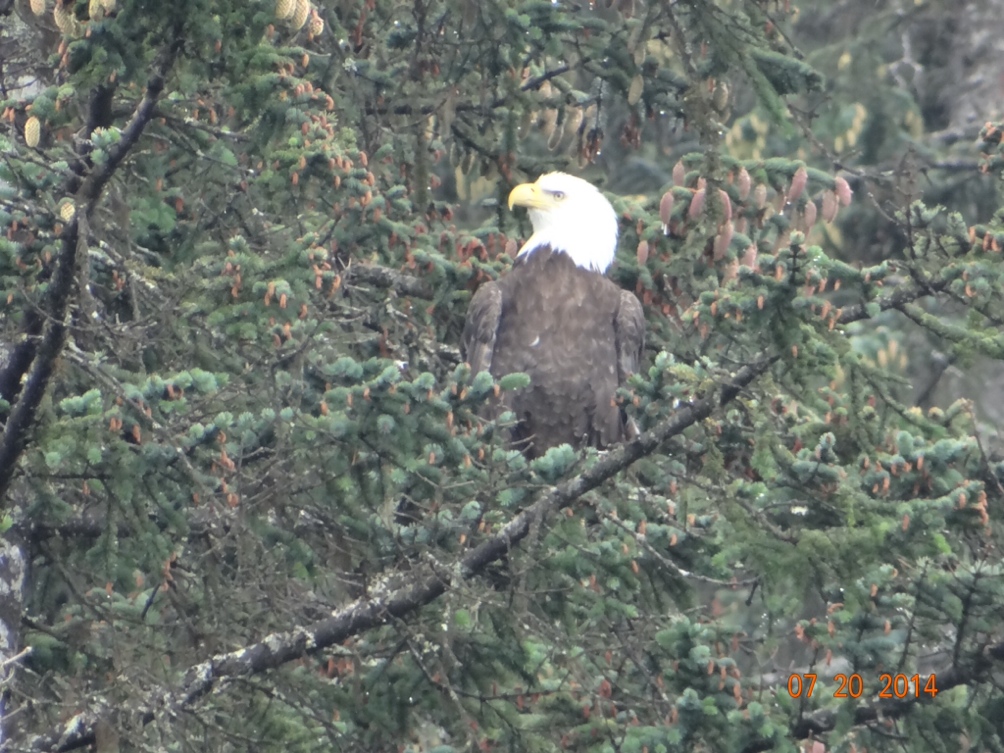
After leaving Valdez we camped and did a car trip into the Wrangell-St Elias National Park and the towns of McCarthy and Kennecott. This involved a sixty mile drive on the McCarthy Road. The road is gravel, and where it is not washboarded it is potholed. Furthermore it is an old railroad bed and the old rail spikes work their way up through the gravel resulting in an abundance of flat tires. (Joan didn’t tell me this until we drove it both ways.) The Kennecott Copper Corp began doing business here in the early 1900’s and the operation continued until the 1930’s when the ore was depleted. Because of the remote location everything used in the mining operation was just left behind when the company pulled out. Today the national park service is stabilizing the buildings and preserving things just as they were. It is a fascinating operation to see. While we were in Kennecott I was looking at an old peice of machinery and trying to figure out what it was used for. Joan had no interest in it so she went down a little road behind the building to check out the view of the glacier below. When she topped the hill she saw a bear about 200 feet below her. Joan used to be a good competitive runner, but now she claims her knees are too bad to run. However, I heard her yell at me and when I looked up she was coming toward me and exhibiting the same running speed that used to win her all of those trophies.
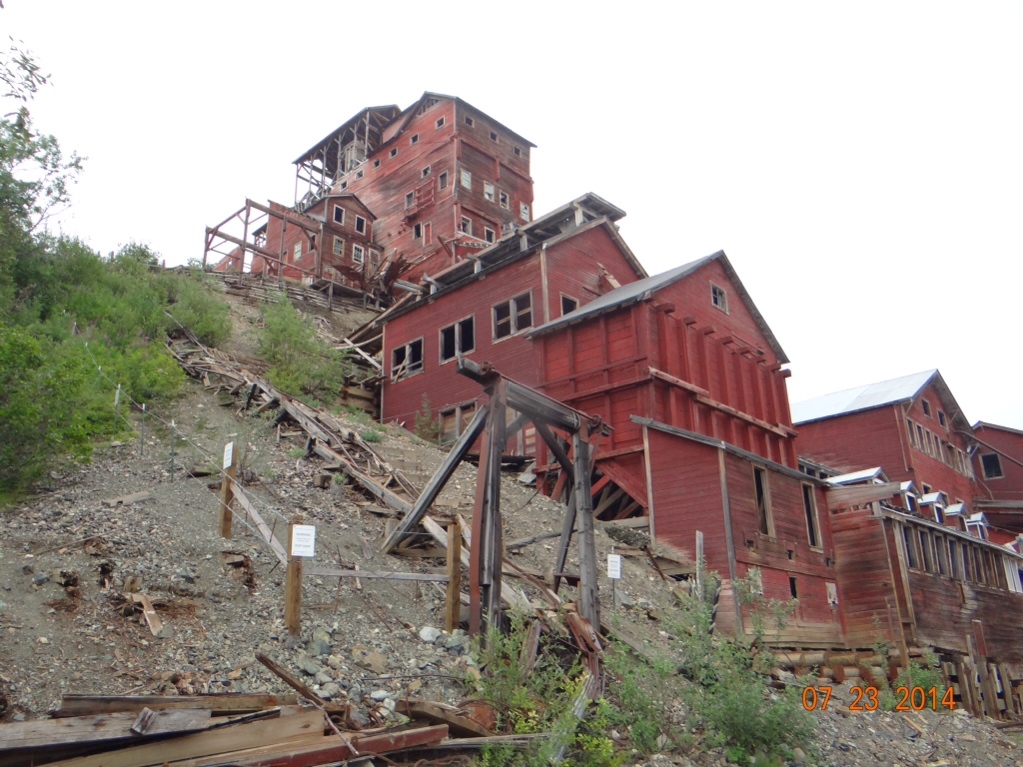

Our final adventure in Alaska was yesterday in the town of Chicken. Chicken is a tiny town way up in the mountains between Alaska and the Yukon Territory in Canada. It has a full time population of 15 which swells to 25 to 30 in the tourist season. It is about sixty five miles from Tok on a road that is closed all winter. They say that in the winter it gets to about eighty below zero. There are no inside toilets in the town and all communication with the outside world is via satellite which is sketchy on overcast days. Gold was discovered near there about five years before the Klondike gold rush. And even today there are some who pan for gold and must find enough to provide a living. Why name your town Chicken? When it was settled the residents wanted to name it Ptarmigan after the northern type of grouse with the feathered legs. However, nobody involved in the naming process was exactly sure how to spell Ptarmigan. So finally they said the hell with it and named it Chicken which is another name that some people of that day used for Ptarmigan. In the center of town is a large statue of a chicken that was fabricated in Homer out of old student lockers from the high school there. It was then transported to Chicken. Im guessing that is a distance of close to three hundred miles.

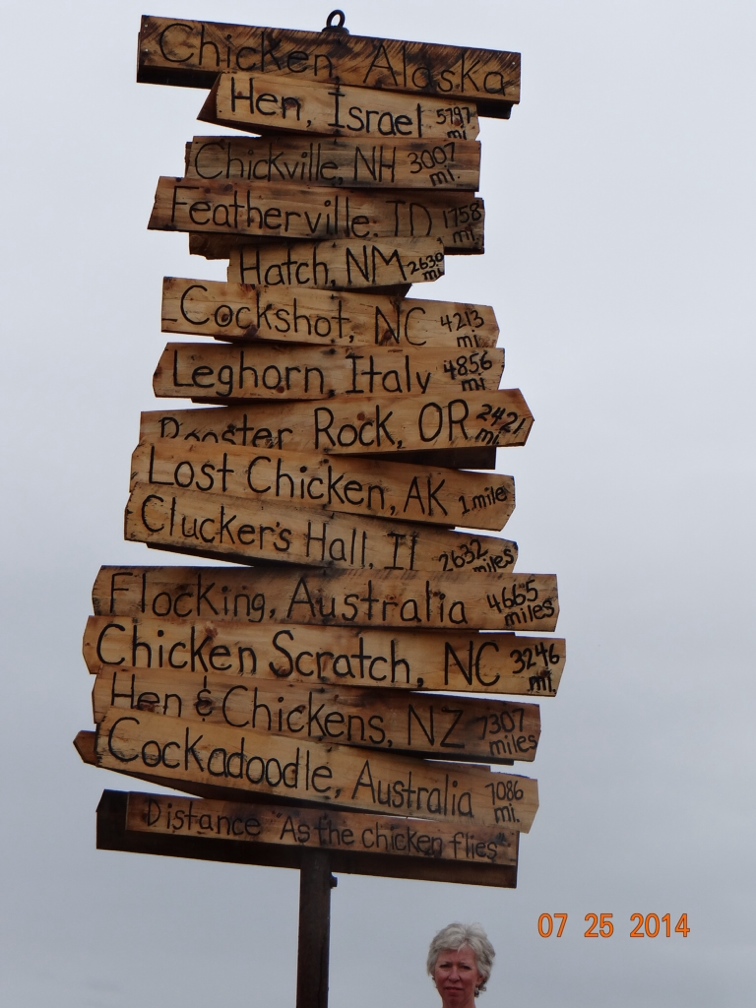
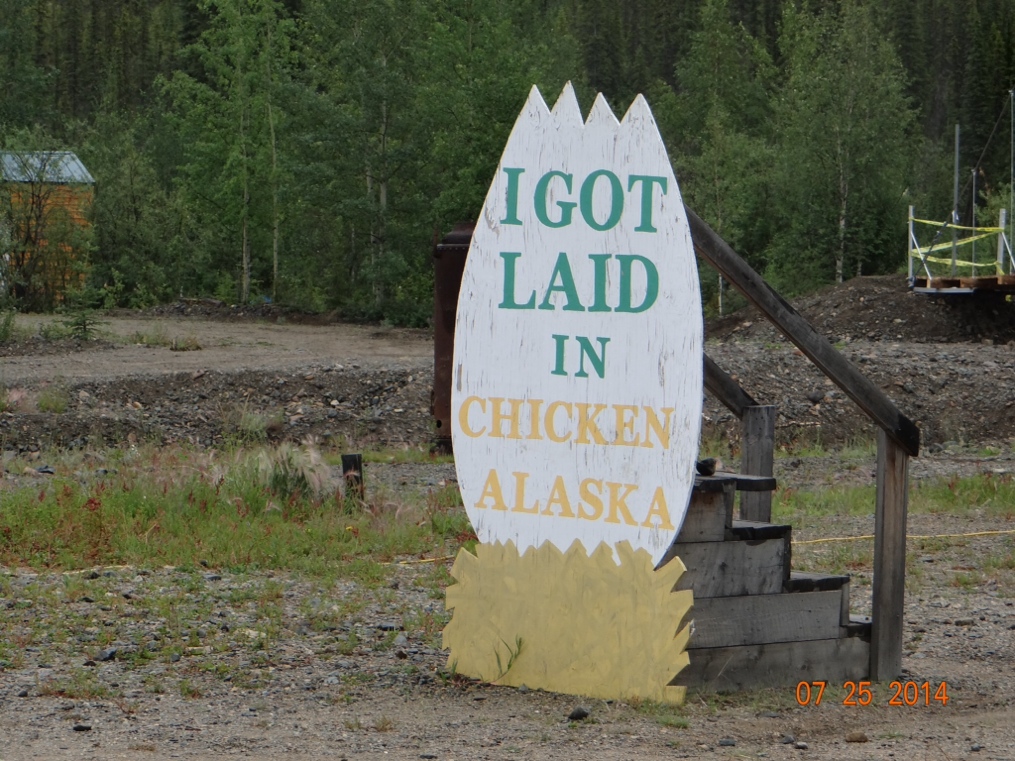
I’ve gotten lots of positive feedback on this blog. People seem to be enjoying reading it. And even though the Alaska portion of the journey is over I plan to continue posting as we head down the coast through Washington, Oregon and California (unless we’ve sold California by then). Along the way we plan to hit as many national parks as is practical and camp in as many state parks as can accommodate our motorhome. So stay tuned.






